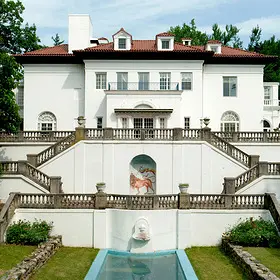The Experimental History Behind the Harlem River Houses

photo by: Wikimedia Commons/Beyond My Ken
Harlem River Houses today.
In the Harlem neighborhood of Manhattan, a group of seven unadorned brick buildings stand tall beside the river. These buildings, collectively called the Harlem River Houses, date to 1937 and represent a milestone in public housing. Along with the Williamsburg Houses in Brooklyn, Harlem River Houses was the first time federal money was used to construct public housing in New York City.
While that alone is significant, the project was much more ambitious from the start. In the 1930s, public housing was segregated in the city. In general, there were few adequate housing options for the city’s African-American community, especially in Harlem. Discriminatory practices by banks resulted in a disproportionately high number of African-Americans who were declared ineligible for mortgage loans and subsequently had little opportunity to move to other neighborhoods. Real estate values in Harlem decreased in the early decades of the 20th century, as did the number of local businesses. The quality of the neighborhood’s tenements decreased as well, creating an overcrowded and often hopeless housing situation for Harlem’s residents. To exacerbate matters, the Great Depression brought about a 25 percent rate of unemployment in Harlem.

photo by: Library of Congress/LC-G612-T-39012
Interior courtyards provided safe community spaces.

photo by: Library of Congress/LC-G612-T01-39010
The buildings were decorated with sculptures and murals.
On the heels of this, the Public Works Administration (PWA) organized a slum clearance committee to focus on housing conditions in New York City in 1933. One year later, New York City mayor Fiorello La Guardia established the New York City Housing Authority (NYCHA) to address the severe conditions in the city's tenement housing. As part of the New Deal, that same year the Housing Division of the PWA was established to plan low-income housing. This began a new era of public housing in the city, and its residents witnessed the construction of dozens of public housing projects. In less than four years, the WPA completed 51 projects across the country, including the Harlem River Houses.
While the philosophy that drove public housing projects and neighborhood revitalization during this time can be considered controversial—to build the Harlem River Houses’ sister project, the Williamsburg Houses, 568 buildings were demolished and 5,400 people were relocated—the buildings that came out of the slum clearance projects in New York City were a modern and novel way that a city dealt with its housing situation. City officials were optimistic for the Harlem River Houses. The bricklaying ceremony included Mayor La Guardia, NAACP president Walter White, and Secretary of the Interior Harold Ickes.
Built during a time of racial tensions in the city, the project represented an attempt to ameliorate conditions in Harlem that were exacerbated by its current housing opportunities. One way the government addressed the sensitive nature of the project was by adding John Louis Wilson, Jr., to the project. This move was politically motivated, given that he was the only African-American architect involved. However, Wilson was more than qualified for the position. In 1928, Wilson became the first African-American graduate of Columbia University’s School of Architecture. He was one of the few African-American licensed architects registered in New York in the 1930s. Following the project, Wilson worked for City Parks Department until 1960 while also running his own practice.
Wilson and the other architects on the team designed the Harlem River Houses in a way that created, in a sense, a neighborhood within a neighborhood. While public housing projects of the time were typically built with brick, the project deviated from typical building practices from its "super block" structure to enclosed plazas and community spaces.
African-American History: More Influential African-American Architects

Including John Louis Wilson, Jr., the 20th century gave birth to several influential African-American architects who left their mark on the country's built environment. We've rounded up a few others whose work you should know.
At five stories, the buildings are low-rise for New York City, which made them more approachable. The complex was centered around large courtyards that offered safety to the residents’ children when they played outside. The apartments all had electrical lights, steam heat, and private bathrooms. These were almost unheard of in other tenement housing in the city, making the Harlem River Houses highly appealing.
When the project opened in 1937, more than 11,000 people applied to live within its 571 apartments spread over nine acres. Lewis Mumford, architecture critic for The New Yorker who is best known for his opposing views on urban planning with Jane Jacobs, praised the Harlem River Houses, citing their access to natural light, safe courtyards, and modern amenities in kitchens and bathrooms as the key to “decent living.”
Harlem River Houses is a product of its environment. In a time of significant racial inequality, the complex stood out as one of the best constructed examples of public housing and a highly desirable place to live for the African-American community.



